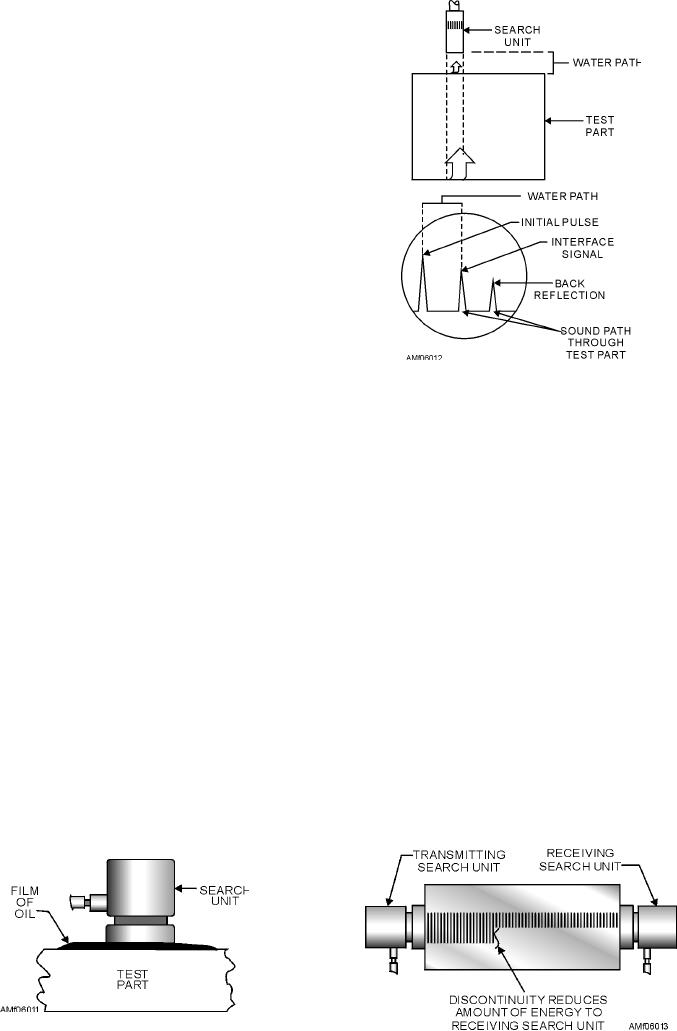
affect the human ear (greater than about 20,000 cycles
per second).
Ultrasonic inspection is a method of inspection that
uses these sound waves. The ultrasonic vibrations are
generated by applying high-frequency electrical pulses
to a transducer element contained within a search unit.
The transducer element transforms the electrical energy
into ultrasonic energy. The transducer element can also
receive ultrasonic energy and transform it into
electrical energy. Ultrasonic energy is transmitted
between the search unit and the test part through a
coupling medium, such as oil, as shown in figure 6-11,
for the purpose of excluding the air interface between
the transducer and the test part. The ultrasonic
vibrations are transmitted into and through the part.
When the beam strikes the far surface of the part or
strikes the boundary of a defect, the beam reflects back
towards the transducer, travels through the couplant,
and enters the transducer, where it is converted back
Figure 6-12.--Immersion method.
into electrical energy. Then, the information is
displayed on a cathode-ray tube (CRT) screen.
receiving search unit or units placed on the
Ultrasonic inspections can be separated into two
same surface). Certain applications use the
basic categories--contact inspection and immersion
through-transmission method (transmitting search unit
inspection. In the contact method, the search unit is
placed on one surface, and receiving search unit placed
placed directly on the test part surface by using a thin
on the opposite surface). In the through-transmission
film of couplant, such as oil, to transmit sound into the
method, discontinuities block the passage of sound.
test part. In the immersion method, the test part is
This results in a reduction of the received signal (fig.
immersed in a fluid, usually water, and the sound is
6-13). With this method, echoes from the dis-
transmitted through the water to the test part (fig. 6-12).
continuities are not shown on the CRT. Therefore,
The immersion-type method is used to inspect
depth information on the discontinuities is not deter-
materials while they are immersed in a suitable liquid,
mined. Typical discontinuity examples are laminations,
such as water or oil. This method proves more
corrosion, and cracks.
satisfactory than contact testing for irregular-shaped
ANGLE BEAM.--Angle-beam methods are used
surfaces. Immersion inspection also permits use of a
extensively for field NDI, and can provide for
wider range of testing frequencies. The three general
inspection of areas with complex geometry or limited
methods of contact inspections are straight-beam,
access. This is because angle beams can travel through
angle-beam, and the surface-wave method.
a material by bouncing from surface to surface. Useful
STRAIGHT BEAM.--The straight-beam method
inspection information can be obtained at great
is used to detect discontinuities parallel to the test
distances from the search unit. Angle-beam inspections
surface, and is generally used on material 1/2 inch thick
are particularly applicable to inspections around
or greater. Most straight-beam methods are applied by
fastener holes, inspection of cylindrical components,
using the pulse-echo technique (transmitting and
Figure 6-11.--Coupling of search unit to test part for
transmission of ultrasonic energy.
Figure 6-13.--Through-transmission inspection.
6-10

